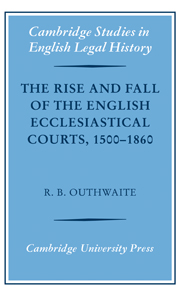Book contents
- Frontmatter
- Contents
- Foreword by R. H. Helmholz
- Preface
- Table of parliamentary statutes
- List of abbreviations
- 1 The ecclesiastical courts: structures and procedures
- 2 The business of the courts, 1500–1640
- 3 Tithe causes
- 4 Wills and testamentary causes
- 5 Defamation suits
- 6 Marital suits and marriage licences
- 7 Office causes
- 8 The roots of expansion and critical voices
- 9 Charting decline, 1640–1830
- 10 Explaining decline
- 11 The bills of 1733–1734
- 12 Snips and repairs: small steps to reform, 1753–1813
- 13 Royal commissions and early fruits, 1815–1832
- 14 Reform frustrated
- 15 Reforms thick and fast, 1854–1860
- Select bibliography
- Index
2 - The business of the courts, 1500–1640
Published online by Cambridge University Press: 21 January 2010
- Frontmatter
- Contents
- Foreword by R. H. Helmholz
- Preface
- Table of parliamentary statutes
- List of abbreviations
- 1 The ecclesiastical courts: structures and procedures
- 2 The business of the courts, 1500–1640
- 3 Tithe causes
- 4 Wills and testamentary causes
- 5 Defamation suits
- 6 Marital suits and marriage licences
- 7 Office causes
- 8 The roots of expansion and critical voices
- 9 Charting decline, 1640–1830
- 10 Explaining decline
- 11 The bills of 1733–1734
- 12 Snips and repairs: small steps to reform, 1753–1813
- 13 Royal commissions and early fruits, 1815–1832
- 14 Reform frustrated
- 15 Reforms thick and fast, 1854–1860
- Select bibliography
- Index
Summary
The Reformation brought few changes in structure and administrative procedures to the English ecclesiastical courts. Headship of the church was transferred from pope to king, necessitating new procedures and institutions to deal with appeals; episcopal boundaries were altered as new dioceses were carved out of old ones; special ecclesiastical commissions became more numerous as the crown sought to deal with spiritual and moral radicalism; and the teaching of canon law in the universities was abolished, though its practice in the largely unchanged ecclesiastical courts was continued.
Nevertheless, the effect of the Reformation upon the business and authority of the church courts has been the subject of debate. Some historians have argued that both business and authority peaked even before the Reformation and that the break with Rome led to further decline. The consistory court of Canterbury experienced a sharp fall in levels of instance causes in the 1490s, and levels continued to decline until 1535. No fewer than 693 such causes were introduced into that court in 1486, but only 93 in 1535. This precipitous decline is almost entirely explained, however, by the diminution of fidei laesio causes, causes which numerically dominated business in late medieval church courts. These could arise from any situation in which an oath to fulfil an obligation had been uttered, but most appear to involve trade debts for relatively small sums, sums perhaps too small or too informal to merit backing with a sealed obligation.
- Type
- Chapter
- Information
- Publisher: Cambridge University PressPrint publication year: 2007



